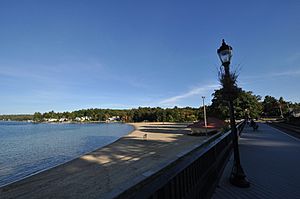Aquadoctan facts for kids

View of the beach at Weirs Beach, looking east toward the outlet of Lake Winnipesaukee
|
|
| Location | Weirs Beach, New Hampshire, |
|---|---|
| Region | Lakes Region (New Hampshire) |
| Coordinates | 43°36′16″N 71°27′21″W / 43.60444°N 71.45583°W |
| History | |
| Founded | c. 9,000 BCE |
| Cultures | Abenaki (Pennacook) |
| Site notes | |
| Excavation dates | 1970s |
| Architecture | |
| Architectural details | Number of temples: |
|
The Weirs
|
|
| Area | 15 acres (6.1 ha) |
| NRHP reference No. | 75000120 |
| Added to NRHP | May 12, 1975 |
Aquadoctan was one of the largest known Native American villages in what is now the U.S. state of New Hampshire. Today, this area is often called The Weirs. This name comes from the special fishing traps, called fishing weirs, that the native people built in the river. The village was located on the north bank of the Winnipesaukee River. This river flows out of Lake Winnipesaukee in the Lakes Region of New Hampshire.
The site is now part of Weirs Beach. This is a popular summer resort and a village within the city of Laconia.
Contents
Discovering Ancient Aquadoctan
Archaeologists have studied the remains of this Native American village. They found evidence of people living there for a very long time. The village stretched for about half a mile along the river. It also went a quarter mile along the lake. People lived here from as far back as 9,000 BCE. They continued to live there until the late 1600s.
Historical records show that most people left the village around 1696. Many of New Hampshire's remaining native people moved away. They joined the Pequawket people in what is now Fryeburg, Maine.
Uncovering the Past: Archaeology at Aquadoctan
Because of its long history of human settlement, the Aquadoctan area has always been important for archaeologists. These are scientists who study human history through digging up old sites.
Formal studies of the area took place from 1976 to 1979. A team from the University of New Hampshire led these digs. In 1977, Howard Sargent also worked there. He was a very important archaeologist in New Hampshire. He is famous for finding the Hunter Archeological Site, another important place in New Hampshire.
What We Found: Evidence from Different Eras
The discoveries at Aquadoctan show that people lived there during the Paleo-Indian period. This period was around 7600 BCE. These very old finds were located under remains from the Middle Archaic time. This shows that people lived in this spot for a very long time.
Aquadoctan was one of the first places in northern New England to show signs of human activity from such ancient times. It helps us understand the prehistoric past of the region.
A Protected Site
A section of the village site, about 15-acre (6.1 ha) in size, is very important. It was added to the National Register of Historic Places in 1975. This helps protect the site for future study.


